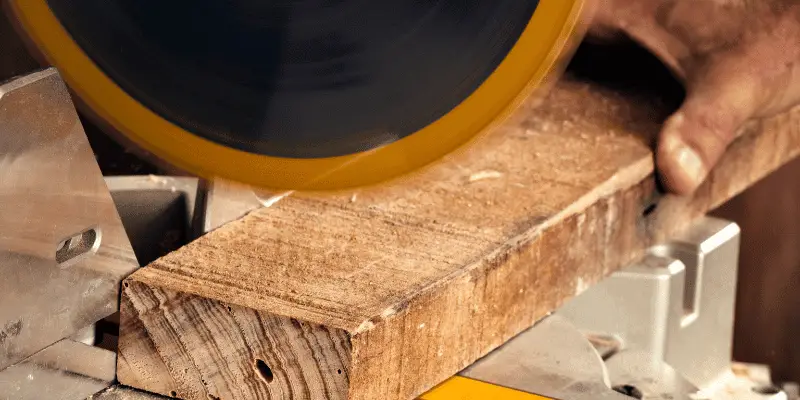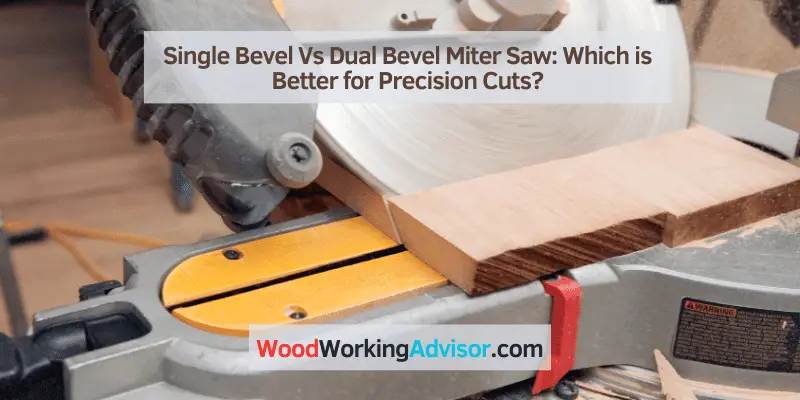A single bevel miter saw can cut angles in one direction, while a dual bevel miter saw can cut angles in both directions. This feature makes the dual bevel saw more versatile for various cutting tasks.
Miter saws are essential tools for woodworking and carpentry projects, offering the ability to make precise angled cuts swiftly and easily. Among the different types of miter saws available, the single bevel and dual bevel miter saws are popular choices.
Understanding the differences between these two types of saws can help professionals and hobbyists select the best tool for their specific project needs. In this guide, we will explore the key distinctions between single bevel and dual bevel miter saws, their advantages and disadvantages, and the practical applications for each type of saw. By the end, you will have a clear understanding of which miter saw is the best fit for your woodworking requirements.
Understanding Miter Saws
Definition And Function
A miter saw is a specialized power tool used for making precise angled cuts. It consists of a pivoting arm and a circular blade to cut wood, metal, or other materials. The single bevel miter saw can only tilt in one direction, while the dual bevel miter saw can tilt in both directions. These saws are commonly used in woodworking, carpentry, and metalworking to create accurate and clean cuts for various projects.
Importance Of Precision Cuts
Precision cuts are critical in woodworking and carpentry. A miter saw is essential for achieving accurate and consistent angle cuts, bevel cuts, and crosscuts. Whether you are working on crown molding, picture frames, or furniture pieces, having the ability to make precise cuts is crucial for professional-looking and high-quality results. The choice between a single bevel and a dual bevel miter saw significantly impacts the efficiency and accuracy of your projects, making it an important decision for any woodworker or carpenter.

Single Bevel Miter Saw
When it comes to cutting accuracy and precision in woodworking, the choice between a single bevel miter saw and a dual bevel miter saw can significantly impact the quality of your projects. In this post, we’ll delve into the specifics of single bevel miter saws, exploring their features, advantages, limitations, and considerations for precision cuts.
Features And Advantages
A single bevel miter saw, as the name suggests, is capable of making bevel cuts in one direction only. This means that the saw blade tilts to the left to make bevel cuts, while the workpiece remains stationary. Here are some of the key features and advantages of single bevel miter saws:
- Single bevel miter saws are typically more affordable than their dual bevel counterparts, making them a budget-friendly option for hobbyists and DIY enthusiasts.
- They are often compact and lightweight, making them easy to maneuver and transport, ideal for smaller workshops or job sites with limited space.
- The simplicity of operation and fewer moving parts make single bevel miter saws easier to maintain and less prone to mechanical issues.
- These saws are well-suited for applications where bevel cuts are primarily made in one direction, such as crown molding or picture framing.
Limitations And Considerations For Precision Cuts
While single bevel miter saws offer several advantages, they also come with limitations and considerations, particularly when it comes to achieving precision cuts:
- The need to flip or adjust workpieces when making bevel cuts in the opposite direction can introduce potential for errors and inconsistencies in angles.
- For complex projects that require bevel cuts in both directions, the single bevel design may lead to longer setup times and increased risk of inaccuracies.
- Precision cutting tasks, such as creating compound miter joints, may necessitate meticulous attention to detail and added caution to ensure the desired angles are achieved accurately.
- It’s important to carefully align and secure workpieces to compensate for the limitations of single bevel miter saws, ensuring the desired level of precision in the final cuts.
Dual Bevel Miter Saw
A dual bevel miter saw offers versatility and convenience for various woodworking and construction projects. Unlike a single bevel miter saw, which requires the workpiece to be flipped to cut bevels on both sides, a dual bevel miter saw allows for seamless adjustments and cuts on both the left and right sides without flipping the material.
Features And Advantages
- Dual Bevel: With the ability to tilt the blade in both directions, this miter saw enables efficient bevel cuts on both the left and right sides.
- Time-Saving: Users can make bevel cuts without the need to reposition or flip the material, saving time and effort during the cutting process.
- Accuracy: The dual bevel feature ensures precise and uniform bevel cuts, enhancing the overall quality of the finished workpieces.
- Versatility: This type of miter saw is ideal for complex projects that require bevel cuts in multiple directions, offering flexibility and adaptability.
Limitations And Considerations For Precision Cuts
- Complexity: The dual bevel miter saw may have a more intricate design compared to its single bevel counterpart, which could require additional care when adjusting and operating.
- Cost: Dual bevel miter saws are often priced higher than single bevel saws, so budget-conscious consumers should weigh the benefits against the cost.
- Maintenance: Due to its more complex mechanics, regular maintenance and adjustments may be necessary to ensure the accuracy and functionality of the dual bevel miter saw.
Precision Cuts Comparison
When choosing between single bevel and dual bevel miter saws, one of the key aspects to consider is the precision cuts that each type of saw can deliver. Let’s do a detailed comparison of the precision cuts offered by single bevel and dual bevel miter saws under the following categories:
Accuracy And Consistency
When it comes to precision cuts, accuracy and consistency are critical. Single bevel miter saws are designed to make bevel cuts in one direction, which can lead to challenges in achieving consistent and accurate cuts. On the other hand, dual bevel miter saws offer the advantage of being able to make bevel cuts in both directions, resulting in enhanced precision and consistency. The ability to tilt the blade in both directions eliminates the need to flip the workpiece, reducing the chances of errors and misalignments.
Versatility And Efficiency
Single bevel miter saws require the movement of the workpiece to make bevel cuts in both directions, which can be time-consuming and decrease efficiency. In contrast, dual bevel miter saws enable users to switch between bevel angles effortlessly, streamlining the cutting process and increasing overall versatility. This versatility and efficiency make dual bevel miter saws the preferred choice for projects that demand a high degree of precision and varied cutting angles.
Ergonomics And User Experience
Dual bevel miter saws often feature improved ergonomic designs that enhance user experience by offering greater comfort and control during use. The ability to make bevel cuts in both directions without having to reposition the workpiece reduces strain on the operator and contributes to a more ergonomic working environment. Single bevel miter saws may fall short in this aspect, potentially leading to user fatigue and decreased efficiency over extended periods of use.
Frequently Asked Questions On Single Bevel Vs Dual Bevel Miter Saw
What Is The Difference Between A Single Bevel And Dual Bevel Miter Saw?
A single bevel miter saw can only tilt in one direction, while a dual bevel miter saw can tilt in both directions. This allows for greater versatility in making bevel cuts without having to flip the workpiece.
What Are The Advantages Of A Single Bevel Miter Saw?
Single bevel miter saws are typically more affordable and simpler to operate than dual bevel counterparts. They are suitable for basic woodworking tasks and can be a good choice for beginners or DIY enthusiasts.
How Does A Dual Bevel Miter Saw Differ From A Single Bevel Miter Saw?
A dual bevel miter saw offers the convenience of tilting the blade to the left or right, eliminating the need to flip the workpiece to make bevel cuts in both directions. This can save time and effort, especially for complex projects.
Conclusion
Both single bevel and dual bevel miter saws have their own advantages. It ultimately comes down to your specific needs and preferences. Whether you prioritize convenience, efficiency, or precision, choose the saw that aligns with your goals. Understanding the differences between the two will help you make an informed decision for your woodworking projects.



One thought on “Single Bevel Vs Dual Bevel Miter Saw: Which is Better for Precision Cuts?”